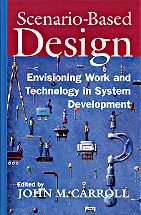 Edited by John M. Carroll
Edited by John M. Carroll
John Wiley, 1995
 Edited by John M. Carroll
Edited by John M. Carroll
John Wiley, 1995
ISBN 0471076597 (boards)
Buy it from Amazon.com (commission paid)
Buy it from Amazon.co.uk (commission paid)
You may also find of interest: Making Use: Scenario-Based Design of Human-Computer interactions
There are extremely few edited collections of chapters on a topic that can be considered as classics -- or even as worth reading -- but this splendid book by Carroll is certainly one.
Carroll begins his Introduction by observing that
There was a time, not too long ago, when it seemed reasonable to view computers chiefly as electronic devices and circuits, as embodiments of computational algorithms. However, through the 1980s computing broadly permeated nearly all arenas of human activity in most Western societies. ...There are many facets to this transformation... One of these is a fundamental rethinking of the goals and methods of system design and development: As technological artifacts, computers must produce correct results... But as artifacts of general culture, [they] must meet many further requirements: they must be accessible to non-technologists; smoothly augment human activities, meet people's expectations, and enhance the quality of life... These latter requirements are far more difficult to specify and to satisfy.
Well, clearly Carroll was starting to think out the challenge of requirements engineering, even if he considered what he was doing to be 'design' (and mainly HCI design, at that), just as Beyer & Holtzblatt did. The emphasis on design had one wonderful consequence on this book: it enabled Carroll to attract a dazzling constellation of experts to attend a 3-day workshop (in 1993) 'on the nature of use-oriented design representations', and then to contribute chapters on the theme, as he explains in the Preface:
The topic is broad -- how to conceptualize work and activity in a way that can proactively guide design efforts, how to envision designs by envisioning their impacts on work and activity, how to direct empirical evaluation of designed tools and environments toward better designs, how to cumulate what is learned in design work. To my mind, this topic lies at the heart of a new view of human-computer interaction, one that conceives of user tasks, system designs, and even implementations as scenarios of interaction.This is a deceptively simple idea. ... Scenarios .. are couched at the level at which people understand and experience their own behaviour. Scenarios also contrast with traditional functional analysis and specification, and with procedure-based decomposition -- developing systems "by scenario" means building object-oriented models of the user's task domain. ... When we design systems and applications, we are, most essentially, designing scenarios of interaction.
I find this exposition perfectly clear and correct a decade later; and there remains a colossal task of education to complete the task that Carroll has begun. It's impossible not to feel that to some extent RE has not fully lived up to the promise inherent in this book: whereas early RE work involved HCI people and ethnographers, the focus does seem to have narrowed, and there seems to be an ever-present danger of talking past people from other communities with different languages -- for instance, why do we keep reinventing AND/OR tree tools when task modellers like the Johnsons were using them ten years ago? So the diversity of this book should be inspiring:
It should be clear just from these titles that many important strands of engineering thought over the last (and I confidently expect also the next) decade are presaged here: user stories, contextual design, scenarios, co-operative / participative development, reusability, object-orientation, use cases, roles, rapid prototyping, gap-bridging, light methods, and more. Classic stuff. What is more, the introduction, the obvious strength of sharing of ideas in the workshop, and the two excellent closing chapters tie the book into a coherent if richly diverse whole -- an example of how it should be done.
This book is now becoming dated as scenario thinking has developed over the last ten years. However it well illustrates the different schools of thought and their separate languages, as researchers come at scenarios from different points of view.
Postscript: I have now helped to bring a book that might be seen as a successor to Carroll's into the world: Scenarios, Stories, Use Cases 2004.
(c) Ian Alexander 2002, 2004